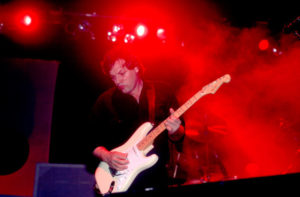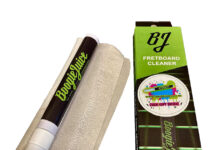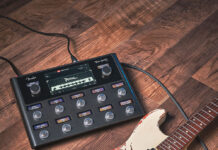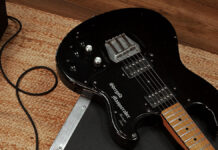
Expert Advice: 35 Ways to Play (and Sound) Better Right Now
We figure that if you’re going to expand and maximize your talents, you might as well learn from the best. So we offer these 35 tips from guitarists who know their stuff—from rock royalty to jazz patriarchs to any-and-all, top-of-their-game bad asses. Hopefully, you’ll find something in these cosmic, practical and musical nuggets of wisdom that will kick that rut-raddled mind of yours into higher gears of inspiration.
If you’re locked away in a basement for eight hours a day with a metronome and a torturous practice book that is equal parts Mel Bay/Guantanamo Bay, you’re still not assured of transcendent six-string skills.
Sure, you might get stenographer-like dexterity and harmonic book-smarts up the f-hole, but playing soul-shaking music often requires a more diverse skill set. But this doesn’t mean that attaining the level of expression produced by someone like Jeff Beck necessitates a life of guitar monk-dom. First, don’t worry about the transcendent and unattainable talent of Jeff Beck. That’s just silly.
What you need to do is ensure that whatever you play makes the hair on your arms stand up and quiver with bliss and excitement.
1. Sing, Sing, Sing
“Before you play a solo phrase, sing it first. Then you’ll know if it’s going to be effective or not. And if you start to sing a line, and find you have to gasp for breath—well, you’ve overextended yourself.” —Ronnie Montrose
2. Use Dynamics
“To work on picking dynamics, plug into a practice amp and turn your guitar all the way up. Then play arpeggios—very quietly at the beginning, and then gradually louder by adjusting your touch. The goal is to vary your dynamics, but not change the position of your hands. Many guitarists change the way they hold their hands when changing dynamics. As a result, they end up with a ‘light-touch’ group of licks—the very fast stuff—but they don’t develop any power. What you want to achieve is continually making those conversions back and forth from quiet to loud picking.” —Jerry Garcia
3. Try Room Miking
“There’s a very old recording maxim that goes, ‘Distance makes depth.’ I’ve used that a hell of a lot—whether it’s tracking guitars or the whole band. People are used to close-miking amps, but I’d have a mic out around the back, as well, and then balance the two. Also, you shouldn’t have to use EQ in the studio if the instruments sound right. You should be able to get the right tones simply with the science of microphone placement.” —Jimmy Page
4. Relax
“The most important thing to remember when you’re attempting to increase your speed is to relax. Don’t push your muscles beyond what they can give. Practice for about a half hour, and then take a break. You can always resume after a few minutes. This is especially important when you’re trying to get seriously twisted patterns under your fingers. I used to sit in front of the TV when I was a kid, and alternate-pick scales very lightly. I wasn’t really paying attention, and it actually helped that I wasn’t concentrating so much, because I stayed relaxed, and yet I was able to build up my technique and stamina. But never keep playing if you start to feel pain. Ever. Tendonitis is no joke.” —Steve Lukather
5. Get Sensitive
“If you’re in a rut with your electric playing, pick up an acoustic. There’s something about playing the acoustic guitar that makes you think about songs. And if you work up solo versions of your favorite pop tunes, you’ll become more aware of how bass lines and harmony fit together. Then, when you go back to electric, those discoveries will help you play more empathetic solos.” —Buck Dharma
6. Get High
“Wherever your guitar is when you’re sitting and practicing is where it should be when you’re standing. I discovered this the hard way. Years ago, I’d practice my solos sitting down—and I’d nail them—only to go to rehearsal and blow it because my right- and left-hand positioning was completely different when I stood up. Now, most players think it looks uncool to wear your guitar up high, but I think it’s cooler to sound kick ass than it is to look cool and suck! Zakk Wylde slings his Les Paul really low, but as soon as a solo comes up, he’ll put his foot on a stage monitor to raise his guitar up. Hell, Tom Morello wears his guitar so high that he says it sometimes hits him in the chin. So, for the sake of killer guitar playing, raise ’em up!” —Rusty Cooley
7. Expand
“Learn everything you know in all keys.” —Joe Pass
8. Move On
“Don’t be precious about anything—much less a certain guitar sound. There is always another interesting sound or effect just waiting to be discovered.” —Robin Guthrie
9. Play Loud
“Start playing loud when you’re young, and you’ll be one step ahead of the game. If you start off playing soft, it will get you into a lot of bad habits. Terrible, terrible, habits. Look at these jazz people. Of course they play soft. It’s a trick so you can’t hear them.” —Nigel Tufnel
10. Slide Right
“Play slide to records to develop accurate intonation. I prefer early Ricky Skaggs albums, because they are full of simple progressions with different grooves in different keys. You don’t want to worry about exotic chords or tricky changes. Stay focused on I-IV-V progressions, and learn how to play through the changes without moving around the neck. You don’t always want to start with the I chord, move up five frets to the IV, and then two more frets for the V.” —Will Ray
11. Be Challenged
“Play with others who are more advanced musically. They will help you rise to their level.” —Bill Kirchen
12. Cork Your Slide
“If you find a slide that sounds great, but is too big for your finger, try cutting a few strips from a wine bottle cork, and gluing them to the inside of the slide. A snug-fitting slide will improve your playing immensely.” —Chris Mule
13. Dig Deeper
“Seek out talented, but lesser known artists from the past and present. Some of the coolest jewels life can offer are found on dusty back roads, miles from the main corporate boulevards of life. And when you find an artist you love, find out who they love.” —Greg V.
14. Appreciate Art
“In the long run, it’s more important to look at paintings than to listen to the way somebody plays bebop lines.” —Jim Hall
15. Think Literally
“Think of a guitar solo as a paragraph. You need a clear beginning, a middle, and an end. Look at musical phrases like sentences, and make sure you break them up using punctuation—or space. You pause naturally when conversing, right? If you don’t, you’ll bore the listener. The same thing will happen with your audience if your solo is one dimensional. You’ll wear them out and lose their attention.” —Tom Principato
16. Get the Bends
“One of the most useful exercises I’ve come across was on a Larry Carlton instructional video. Larry would play a major scale in fifth position, going up one octave, from the third string to the first string. He then proceeded to do the same scale, but he’d bend the majority of it. The best part of this exercise is that you do it the same way in reverse. This way, you learn to bend up in pitch, but also pre-bend and descend in pitch. The major scale is a wonderful reference for articulating and intonating your bends, because pretty much everyone can hear its intervals clearly, and will know if they’re sharp or flat. It’s a demanding exercise, and yet its kind of pretty.
“Then, practice Beatles songs, standards, and folk songs by using bends to play the melody, rather than traditional fingering. This is a very demanding and rewarding musical exercise that will teach you more than, say, approximating the solo of ‘Little Wing.’” —Jim Campilongo
17. Love You Less
“Listen more to the other players on the bandstand than you do to yourself.” —Bill Kirchen
18. Get Ear Training
“For some basic ear training, play any note on your guitar. In this case, let’s say it’s an A. Then pick an interval out of the air—say a perfect fifth, E. Now, try to sing the E note, and then play the same note on your instrument. See how close you came. Don’t play the interval before you try to sing it. Then you’re only imitating, not ear training. Force your brain to seek out and determine the interval you’ve chosen. Start off easy with octaves, perfect fifths, major and minor thirds, and then move on to more difficult major sixths, sevenths, seconds, flat fifths, and so on.” —Rik Emmett
19. Screw Up
“Don’t worry about a bit of slop. Instead, put truth in every note. Music isn’t about playing with absolute perfection—it’s the intense and soulful commitment to the note.” —Greg V.
20. Seek Truth
“Don’t listen to unimaginative naysayers when it comes to personal creative expression. At some point, there will no doubt emerge a conflict between the rules of instrumental mastery, and the need to follow one’s own intuition. Be strong! The only so-called advancements in art—forget about commerce—have come about when someone has either boldly modified or completely disregarded the norm. Those who deviate must stay true to themselves.” —Nels Cline
21. Get Evocative
“What is it exactly that moves you when you hear a guitarist you love? I think it’s the relation between the player’s emotional feeling and their muscle action on the guitar. To connect with this idea, first experiment with the full range of your muscle power, trying to play the same riff with an angry feel, a tender feel, and everything in between. Then, take a song you know, and try to increase the sonic contrast from verse to chorus, or section to section. Use this range of sound to better sculpt the landscape of the song.” —Bob Brozman
22. Try Being Quieter
“Experiment with not being the loudest thing on stage.” —Bill Kirchen
23. Read More
“Spend at least 15 minutes per guitar magazine learning something from a lesson. Some of the concepts I’ve learned by doing this have stuck with me for years!” —Dave Wronski
24. Get Bluesy
“Study jazz soloing using the 12-bar blues form. Most players want to start playing long bebop lines from the start, but the simpler the melodic material is, the sooner you begin to develop a sense of phrasing. In turn, this will give you greater soloing freedom, because you’ll have a larger rhythmic vocabulary at your disposal.” —Lenny Breau
25. Wrap it Up
“Remember that the reputations of some of the greatest jazzmen ever are built on eight-bar solos. Too many guitarists play solos that are way too long.” —Jim Hall
26. Do for Others
“Recording your own music is one thing, but having to deliver something for somebody else is entirely different. Session work makes you more critical about your playing. You can’t hit notes all over the place, you’ve got to make each note count, and if you can’t play really clean, it all sounds like a mess. You may think you sound fabulous onstage, but when you hear yourself played back in the studio, it’s just disastrous most of the time. But if you can play well in the studio, you can play well onstage.” —Ritchie Blackmore
27. Find You
“A good way to crave your individuality is to get a tape recorder and get into a room that’s kind of dark—where you don’t have interruptions—and then just play with a rhythm machine. After a while, it’s like a deck of cards on the table, and you can begin to see the riffs that came from this guy, the riffs that came from that guy, and then the two or three riffs that are yours. Then you start concentrating on your riffs until you develop an individual sound.” —Carlos Santana
28. Mix It Up
“Treat each guitar track—and each song—completely different. For example, if I’m using a certain amp and guitar on one track, I’ll deliberately use something else for the next tune or overdub.” —Keith Richards
29. Balance Your Pickups
“To balance your pickups, plug your guitar into something with level meters, such as a 4-track recorder. Play each string individually, and adjust the pickup height until the level of each string hits the same point on the meters. Typically, you’ll have to lower the bass side of the pickup. If your guitar’s overall output is quieter than what you had, simply turn up your amp to compensate. The benefit here is string-to-string clarity.” —Dave Wronski (of Slacktone, below)
30. Go Big
“Use big strings. I like a set with a .013 E string, but I’ve gone as high as a .018-.074 set. They’ll eat your hands, your tuning pegs, and your amp, but they sound great.” —Stevie Ray Vaughan
31. Try Moderation
“Over-indulgence in anything is wrong—whether it’s practicing 50 hours a day, or eating too much food. There’s a balance with me, as there should be with everything and everybody. I’ve tried to keep it so that I’m able to execute the ideas that come out, but practicing too much depresses me. I get good speed, but then I start playing nonsense because I’m not thinking. A good layoff makes me think a lot. It helps me get both things together—the creativity and the speed.” —Jeff Beck
32. Be Aware
“Remind yourself that you’re free to feel great instead of reserved or insecure. When you’re feeling good, you’re more apt to take chances onstage, and if you make a bunch of mistakes, it won’t matter. It’s almost like you’re the instrument, and the music is flowing through you like electricity. Like John Coltrane said—the paramount aspect of being a musician is to try to get more in touch and in tune with yourself. When you do that, it’s like returning to the center and everything emanates from there. You automatically become a better musician in becoming a more aware individual.” —Eric Johnson
33. Go Big (Again)
“If you’re going to go out of the norm, go all the way. Don’t just go out a little bit. If you’re scared to go out there, then stay in the norm—just learn to play really well in 4/4. But if you want to go beyond that, you must in a totally different direction. If you want to count odd meters, they’re all broken down into groups of twos and threes. And I’m not just talking about tinier subdivisions. What it amounts to is ritardos [slowing down] and accelerandos [speeding up] inside of a bar, mathematically worked out so that instead of bomp, bomp, bomp, bomp—four beats in a bar—you get other kinds of action, where the time inside of the bar goes faster, goes slower, and goes faster again. But it all comes out on the downbeat of the next bar so you can still tap your foot to it.” —Frank Zappa
34. Separate
“Try to separate yourself from what your fingers are doing and listen to the amp.” —Steve Vai
35. Use Melodic Delays
“A bit of delay can smooth out the unpleasant, raw frequencies you get from a fuzz box. I have two units, and I have different echo settings on both. There are times when I have both running at the same time for certain effects. During solos, I usually try to set the delays to have some rhythmic time signature in common with the tune. I usually set them to a triplet—the notes all intertwine, so it doesn’t really matter anyway, but I find that a triplet delay is very melodic.” —David Gilmour
Source: www.guitarworld.com











